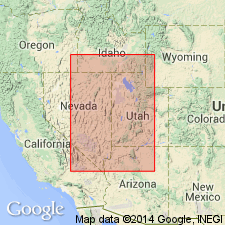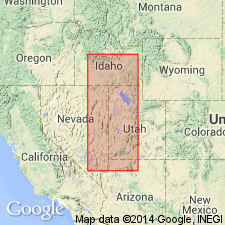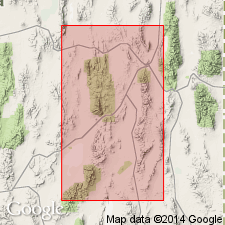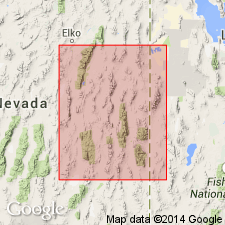
- Usage in publication:
-
- Illipah formation
- Modifications:
-
- Areal extent
- Dominant lithology:
-
- Sandstone
- Conglomerate
- Shale
- AAPG geologic province:
-
- Great Basin province
Summary:
Pg. 76. Mentioned in summary of structural history of Great Basin province in Utah and eastern Nevada. Referred to as tongues of sandstone and conglomerate that lense eastward into dark-gray marine shales. Age is Late Mississippian.
Source: US geologic names lexicon (USGS Bull. 1200, p. 1858-1859).

- Usage in publication:
-
- Illipah formation
- Modifications:
-
- Overview
- AAPG geologic province:
-
- Great Basin province
Summary:
Pg. 1427 (fig. 3), 1433 (fig. 9), 1434-1435 (fig. 10). Illipah formation. As shown on correlation chart and diagrams, the Illipah underlies Ely, Callville, and Bird Spring formations and overlies Chainman, Rogers Spring, and Monte Cristo formations.
Source: US geologic names lexicon (USGS Bull. 1200, p. 1858-1859).

- Usage in publication:
-
- Illipah formation
- Modifications:
-
- Not used
- AAPG geologic province:
-
- Great Basin province
Summary:
Pg. 81-82, 83 (fig. 1), 84. Discussion of aspects of Chainman formation. The Chainman is recognized as a valid stratigraphic unit. Rather than formally recognize Diamond Peak and Scotty Wash as distinct units, the writer [Sadlick] prefers to refer to these as facies within the Chainman. Term Illipah (Christiansen, 1951) is suppressed as synonomous with Diamond Peak, and term should not be used for limestone sequence in upper part of Chainman.
Source: US geologic names lexicon (USGS Bull. 1200, p. 1858-1859).

- Usage in publication:
-
- Illipah formation
- Modifications:
-
- Not used
- AAPG geologic province:
-
- Great Basin province
Summary:
Pg. 99. Scotty Wash quartzite of Pioche district and Illipah sandstone of Hamilton district are same lithogenetic units. Scotty Wash quartzite has priority; recommended that name Illipah be abandoned.
Source: US geologic names lexicon (USGS Bull. 1200, p. 1858-1859).
For more information, please contact Nancy Stamm, Geologic Names Committee Secretary.
Asterisk (*) indicates published by U.S. Geological Survey authors.
"No current usage" (†) implies that a name has been abandoned or has fallen into disuse. Former usage and, if known, replacement name given in parentheses ( ).
Slash (/) indicates name conflicts with nomenclatural guidelines (CSN, 1933; ACSN, 1961, 1970; NACSN, 1983, 2005, 2021). May be explained within brackets ([ ]).

